
Art Nouveau is an international style of art, architecture, and applied art, especially the decorative arts. It was often inspired by natural forms such as the sinuous curves of plants and flowers. Other characteristics of Art Nouveau were a sense of dynamism and movement, often given by asymmetry or whiplash lines, and the use of modern materials, particularly iron, glass, ceramics and later concrete, to create unusual forms and larger open spaces. It was popular between 1890 and 1910 during the Belle Époque period, and was a reaction against the academicism, eclecticism and historicism of 19th century architecture and decorative art.

Kirkkonummi is a municipality in Finland, located in the southern coast of the country. Kirkkonummi is situated in the western part of the Uusimaa region. The population of Kirkkonummi is approximately 41,000. It is the 28th most populous municipality in Finland. Kirkkonummi is part of the Helsinki Metropolitan Area, which has approximately 1.58 million inhabitants.
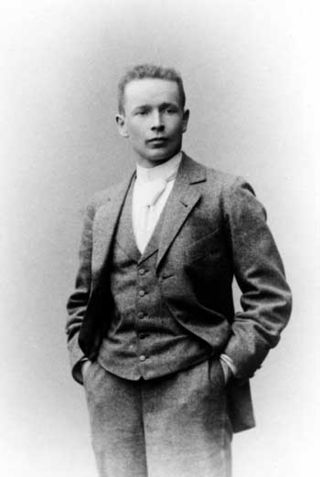
Gottlieb Eliel Saarinen was a Finnish-American architect known for his work with Art Nouveau buildings in the early years of the 20th century. He was also the father of famed architect Eero Saarinen.
The year 1910 in architecture involved some significant architectural events and new buildings.

Lars Eliel Sonck was a Finnish architect. He graduated from Helsinki Polytechnic Institute in 1894 and immediately won a major design competition for a church in Turku, St Michael's Church, ahead of many established architects. The church was designed in the prevailing neo-Gothic style. However, Sonck's style would soon go through a dramatic change, in the direction of Art Nouveau and National Romanticism that was moving through Europe at the end of the 19th century. During the 1920s, Sonck would also design a number of buildings in the emerging Nordic Classicism style.
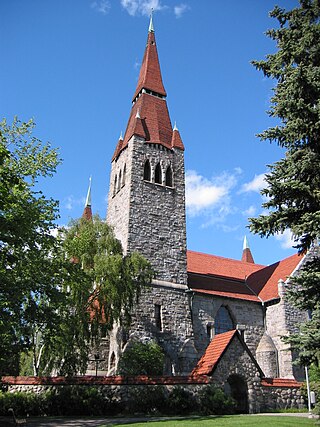
The National Romantic style was a Nordic architectural style that was part of the National Romantic movement during the late 19th and early 20th centuries. It is often considered to be a form of Art Nouveau.

Hvitträsk is a mansion complex in Kirkkonummi, Finland, about 30 kilometers (19 mi) west of Helsinki. It was designed as a studio home by the members of the Finnish architecture firm Gesellius, Lindgren, Saarinen, later becoming the private residence of Eliel Saarinen. It currently operates as a museum.
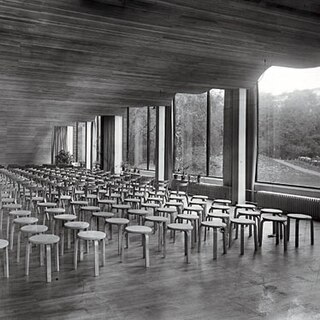
The architecture of Finland has a history spanning over 800 years, and while up until the modern era the architecture was highly influenced by Sweden, there were also influences from Germany and Russia. From the early 19th century onwards influences came directly from further afield: first when itinerant foreign architects took up positions in the country and then when the Finnish architect profession became established.

Armas Eliel Lindgren was Finnish architect, professor and painter.
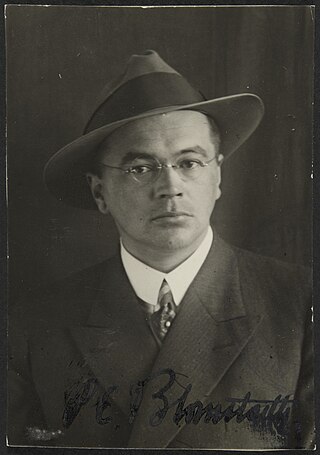
Pauli Ernesti Blomstedt, more commonly known as P. E. Blomstedt, was a Finnish architect and designer, who worked first in the Nordic Classicism style and then turned to Functionalism. Both his father, Yrjö Blomstedt, and younger brother, Aulis Blomstedt, were also well-known architects.

Zachris Usko Nyström, known as Usko Nyström, was a Finnish architect and one of the most influential professors of architecture at Helsinki University of Technology; among his students were later notable architects Eliel Saarinen and Alvar Aalto. One of the pioneering architects of the early Art Nouveau or Jugendstil style in Finland at the end of the 19th and beginning of the 20th century, he continued to influence generations of students by introducing them to the style. Many of his key architectural works were made while he was in the architectural partnership Usko Nyström─Petrelius─Penttilä which operated from 1895 to 1908. His most famous work is the Grand Hôtel Cascade (1903) in Imatra.

Fabianinkatu 17 is a national romantic-art nouveau building in central Helsinki. Built in 1900–1901 to a design by the architectural firm of Gesellius, Lindgren and Saarinen, it was originally a block of flats, but became increasingly used for offices and was for many years known as the Doctors' House. In 1953 Agronomiliitto, the Finnish Association of Agronomists, bought it, and it is now called Agronomitalo.

The Pohjola Insurance building is the former headquarters of the Pohjola Insurance Company at Aleksanterinkatu 44 and Mikonkatu 3 in central Helsinki. Primarily designed by Gesellius, Lindgren & Saarinen and constructed in 1899–1901, it is a prominent example of Finnish national romantic architecture. It was acquired in 1972 by Kansallis-Osake-Pankki, now succeeded by Nordea.
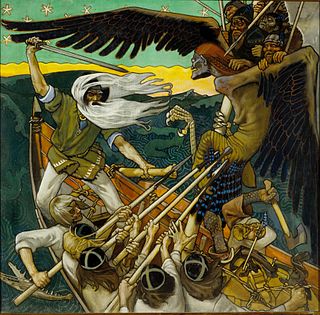
The Golden Age of Finnish Art coincided with the national awakening of Finland, during the era of the Grand Duchy of Finland under the Russian Empire. It is believed to span an era from the late 19th Century to the early 20th Century, approximately 1880 to 1910. The epic poetry form known as Kalevala, developed during the 19th Century, provided the artistic inspiration for numerous themes at the time, including in visual arts, literature, music and architecture; however, the "Golden Age of Finnish Art" is generally regarded as referring to the realist and romantic nationalist painters of the time. Notable figures of the time include Akseli Gallen-Kallela, Pekka Halonen, Albert Edelfelt, Jean Sibelius, Eino Leino, Helene Schjerfbeck, Emil Wikström, Eero Järnefelt and Eliel Saarinen.

Minna Carolina Mathilde Louise "Loja" Gesellius was a Finnish-American textile artist and sculptor. She founded the weaving department at the Cranbrook Academy of Art in Michigan. She also led her own studio, the Studio Loja Saarinen, which designed many of the textiles used in buildings designed by her husband, the architect Eliel Saarinen.

Art Nouveau is an international style of art, architecture and applied arts, especially the decorative arts, that was most popular between 1893 and 1910. In the Russian language it is called Art Nouveau or Modern.
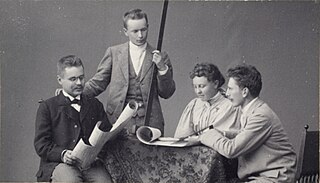
Gesellius, Lindgren, Saarinen was a Finnish architecture firm, founded in Helsinki in 1896 by architects Herman Gesellius, Armas Lindgren and Eliel Saarinen.

The Vyborg (Viipuri) railway station built in 1913 was the second railway station built in Vyborg, Grand Duchy of Finland. The station, which had replaced Vyborg's first railway station was almost completely destroyed in 1941 during the Continuation War, and only the part that had acted as a cargo office remains. The present Vyborg railway station was built in 1953.

Carl Petter Daniel Dyrendahl Nyblin was a Norwegian photographer who spent most of his life in Finland.

Mikonkatu is a street in central Helsinki, Finland, leading north from the Esplanadi Park to the Kaisaniemi Park, mostly converted into a pedestrian street in 1992.





















